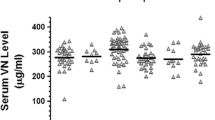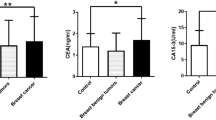Abstract
Early diagnosis is the key for the successful treatment of breast cancer. A serum marker for the early detection of breast cancer could significantly reduce breast cancer morbidity and mortality by bringing the time of diagnosis at an earlier and therefore still curable stage. So far, no biomarker for the early detection is available for the clinical routine. The aim of the present study was to evaluate the use of calponin-h2 as a blood-based biomarker for the early diagnosis of this disease. Using two monoclonal antibodies against calponin-h2, we developed a sandwich ELISA to analyze the serum levels of calponin-h2. In order to evaluate the diagnostic potential of this biomarker, patients with breast cancer (n = 76), benign diseases of the breast (n = 51) and healthy females (n = 24) were analyzed. Serum levels above 10 ng/ml were only observed in patients with breast cancer (n = 8; 10.5 %). Further large-scale studies and preanalytic evaluations are necessary to clarify the definite role of calponin-h2 as a biomarker in breast cancer management.



Similar content being viewed by others
References
Arriagada R, Rutqvist LE, Johansson H, Kramar A, Rotstein S. Predicting distant dissemination in patients with early breast cancer. Acta Oncol. 2008;47:1113–21.
Cianfrocca M, Goldstein LJ. Prognostic and predictive factors in early-stage breast cancer. Oncologist. 2004;9:606–16.
Berry DA, Cronin KA, Plevritis SK, Fryback DG, Clarke L, Zelen M, et al. Effect of screening and adjuvant therapy on mortality from breast cancer. N Engl J Med. 2005;353:1784–92.
Smith RA, Cokkinides V, Brooks D, Saslow D, Brawley OW. Cancer screening in the United States, 2010: a review of current American Cancer Society guidelines and issues in cancer screening. CA Cancer J Clin. 2010;60:99–119.
Tabar L, Yen MF, Vitak B, Chen HH, Smith RA, Duffy SW. Mammography service screening and mortality in breast cancer patients: 20-year follow-up before and after introduction of screening. Lancet. 2003;361:1405–10.
Jorgensen KJ, Gotzsche PC. Overdiagnosis in publicly organised mammography screening programmes: systematic review of incidence trends. BMJ. 2009;339:b2587.
Buist DS, Porter PL, Lehman C, Taplin SH, White E. Factors contributing to mammography failure in women aged 40-49 years. J Natl Cancer Inst. 2004;96:1432–40.
IARC (2002) IARC Handbooks of cancer prevention: breast cancer screening. IARC Press
Heron MP, Hoyert DL, Murphy SL, Xu JQ, Kochanek KD, Tejada-Vera B. Death: final data for 2006. National vital statistics reports; vol 57 no 14. Hyattsville, MD: National Center for Health Statistics. 2009. Ref Type: Report
Schopper D, de Wolf C. How effective are breast cancer screening programmes by mammography? Review of the current evidence. Eur J Cancer. 2009;45:1916–23.
Anderson BO, Yip CH, Ramsey SD, Bengoa R, Braun S, Fitch M, et al. Breast cancer in limited-resource countries: health care systems and public policy. Breast J. 2006;12 Suppl 1:S54–69.
Golubnitschaja O, Yeghiazaryan K, Costigliola V, Trog D, Braun M, Debald M, et al. Risk assessment, disease prevention and personalised treatments in breast cancer: is clinically qualified integrative approach in the horizon? EPMA J. 2013;4:6.
Harris L, Fritsche H, Mennel R, Norton L, Ravdin P, Taube S, et al. American Society of Clinical Oncology 2007 update of recommendations for the use of tumor markers in breast cancer. J Clin Oncol. 2007;25:5287–312.
Debald M, Franken S, Heukamp LC, Linke A, Wolfgarten M, Walgenbach KJ et al (2011) Identification of specific nuclear structural protein alterations in human breast cancer. J Cell Biochem
Takahashi K, Hiwada K, Kokubu T. Isolation and characterization of a 34,000-dalton calmodulin- and F-actin-binding protein from chicken gizzard smooth muscle. Biochem Biophys Res Commun. 1986;141:20–6.
Jin JP, Zhang Z, Bautista JA. Isoform diversity, regulation, and functional adaptation of troponin and calponin. Crit Rev Eukaryot Gene Expr. 2008;18:93–124.
Wu KC, Jin JP. Calponin in non-muscle cells. Cell Biochem Biophys. 2008;52:139–48.
Tang J, Hu G, Hanai J, Yadlapalli G, Lin Y, Zhang B, et al. A critical role for calponin 2 in vascular development. J Biol Chem. 2006;281:6664–72.
Jin JP, Wu D, Gao J, Nigam R, Kwong S. Expression and purification of the h1 and h2 isoforms of calponin. Protein Expr Purif. 2003;31:231–9.
Drucker E, Krapfenbauer K. Pitfalls and limitations in translation from biomarker discovery to clinical utility in predictive and personalised medicine. EPMA J. 2013;4:7.
Poste G. Bring on the biomarkers. Nature. 2011;469:156–7.
Anderson BO, Yip CH, Ramsey SD, Bengoa R, Braun S, Fitch M, et al. Breast cancer in limited-resource countries: health care systems and public policy. Breast J. 2006;12 Suppl 1:S54–69.
Anderson BO, Yip CH, Smith RA, Shyyan R, Sener SF, Eniu A, et al. Guideline implementation for breast healthcare in low-income and middle-income countries: overview of the Breast Health Global Initiative Global Summit 2007. Cancer. 2008;113:2221–43.
Debald M, Wolfgarten M, Walgenbach-Brünagel G, Kuhn W, Braun M. Non-invasive proteomics-thinking about personalized breast cancer screening and treatment. EPMA J. 2010;1:413–20.
Waerner T, Thurnher D, Krapfenbauer K. The role of laboratory medicine in healthcare: quality requirements of immunoassays, standardisation and data management in prospective medicine. EPMA J. 2010;1:619–26.
Acknowledgments
Manuel Debald is funded by BONFOR, University of Bonn.
Conflict of interest
None
Author information
Authors and Affiliations
Corresponding author
Rights and permissions
About this article
Cite this article
Debald, M., Jin, JP., Linke, A. et al. Calponin-h2: a potential serum marker for the early detection of human breast cancer?. Tumor Biol. 35, 11121–11127 (2014). https://doi.org/10.1007/s13277-014-2419-6
Received:
Accepted:
Published:
Issue Date:
DOI: https://doi.org/10.1007/s13277-014-2419-6




